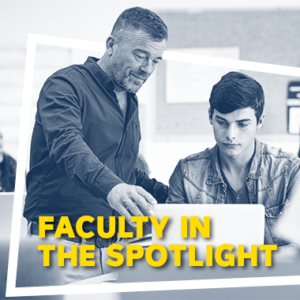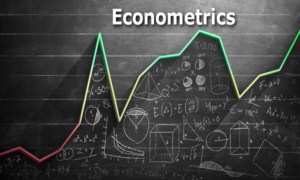“Faculty in the spotlight” with Mikayel Vardanyan
 With more than 700 professors, including 175 permanent professors-researchers, IÉSEG offers to its students a high-quality learning experience, based on 4 key elements: an active, interdisciplinary learning process, focused on the acquisition of competencies, offered through customized curricula.
With more than 700 professors, including 175 permanent professors-researchers, IÉSEG offers to its students a high-quality learning experience, based on 4 key elements: an active, interdisciplinary learning process, focused on the acquisition of competencies, offered through customized curricula.
Each month, “Faculty in the spotlight” invites you to meet one of the School’s professors who presents their vision of teaching, their methods for transmitting their expertise and passion to students and shares their best memories and stories at IÉSEG.
This month, we are meeting Mikayel Vardanyan, Professor of Economics and Head of the Economics and Quantitative Methods Department.
Mikayel, what was your background before joining IÉSEG ?
I grew up in Armenia and went to the United States when I was in my early twenties to study at Oregon State University, where I earned my Ph.D. in Economics in 2005. My teaching career started there (I taught microeconomics, macroeconomics, managerial economics and econometric analysis) before moving to Europe about thirteen years ago, first to Luxembourg and then on to France, and joining IÉSEG in 2010.
What subject(s) do you teach? How could you sum it up in a few words?
I currently teach courses in quantitative methods to our Master “Grande École” program students, as well as students enrolled in specialized programs such as International MBA and Master of Science in Fashion Management.
I focus on the methods that help quantify relationships among various variables and test if these relationships are even valid. For example, we may suspect that the price of the product we sell and the demand for this product move in the opposite directions, but can any particular store claim that this so-called negative relationship is really as strong as the science claims it is? What form does that relationship take? What exactly will happen to the sales at that store if the products it sells are made cheaper to its customers?
This is only one of a very large number of real-world examples I could bring. We also look at many other examples allowing us to understand what determines the success of a film, which factors help a team win a game, how to suggest the best location for a new store or restaurant, if ethnic background plays a role in securing access to a mortgage or car loan, or why so many male passengers perished during the Titanic disaster.
How has the teaching of your subject evolved over time?
The courses I teach at IÉSEG are relatively complex, so it was sometimes difficult for me to capture my students’ attention and stimulate interest towards the content of my courses in the past. I have restructured my courses and now begin with very basic analysis before slowly rendering it more difficult but also more realistic in a systematic manner. In addition to the changes to the course structure, I am always on a lookout for additional examples to discuss in class.
Why did you choose to become a professor? How do you integrate the Vision “Empowering Changemakers for a Better Society”?

©University of York
As educators, we find ourselves in an enviable position of being able to help build a better future – both for the students themselves and for our communities in general. This is perfectly in line with IÉSEG’s vision of empowering changemakers for a better society. Understanding that my input as a teacher helps bring positive change has always been a source of motivation and tremendous joy for me.
I view my contribution as being part of the broad process that empowers people through knowledge in general. One way of thinking about education is to view it as a process whereby the students acquire hands-on skills they can subsequently apply in the workplace to solve concrete problems. I believe my emphasis on the tools for analyzing causality along with the attention I attribute to demonstrating their applicability to the real-world situations can help our students achieve that goal.
However, another way to think about education and the change it brings is to consider what we economists call positive externalities, i.e. additional benefits to a society whose members are educated enough not just to understand how to interpret new information to make better decisions, but also be able to, for example, distinguish between trustworthy information and fake news. Therefore, I see what I do as part of the solution to eliminating some of the ignorance responsible for many of today’s societal problems.
According to your students, what are your strengths as a teacher?
My students often say that they greatly appreciate the way in which I structure my courses. They also seem to value the quality of the feedback I offer and the clarity of the explanations I give. I teach my classes with enthusiasm and energy and I think the students appreciate that. Quite a few of my former students have expressed appreciation for what they describe as a professional approach. They also wish they could have had additional class time to study relatively advanced topics or consider additional examples they find so interesting.
How do you pass on your passion to your students?
One of the most important things I learned through the years is that an energetic teaching style always helps keep the audience engaged, nurtures its curiosity, and facilitates the learning process. I avoid lecturing for more than around twenty-five minutes at a time to help my students maintain their concentration level. I had once asked a colleague at a U.S. university where I used to teach at the time to sit in on one of my lectures. After the lecture ended, he told me he thought my approach for delivering content was not just teaching per se and could almost be described as performing in front of my audience…
How do you support students in their learning?
I continuously offer in-class feedback while my students work on class projects and are unsure about which answers to provide. I also give extensive oral feedback during the last session, which in some cases is devoted to the presentation of the students’ final reports. I take time to explain what could have been done differently, allowing my students to reinforce the knowledge they acquired by offering opportunities for reflection. I also try to illustrate the theory using real-world examples and subsequently ask the students to practice them using Excel or other types of software. Finally, I remember to use something that has never failed to help me when dealing with people in general – empathy. I truly believe in second chances and always go out of my way to understand and help solve the difficulties many of my students encounter when dealing with my relatively challenging course content. When I answer questions, I do so with encouragement, patience, and even compassion.
How has the School evolved since you arrived?
IÉSEG has changed dramatically since 2010. Apart from the rapid increase in our size and our remarkably improved ranking among the other business schools in France and abroad, I am very proud of our noticeably improved curricula and expanded program portfolio. As Head of Department, I have had the privilege of witnessing this transformation firsthand and directly contributing to it. At the level of our Department, we now have twice as many permanent faculty members as we had ten years ago. They share their expert knowledge by teaching a variety of specialized courses on a number of different programs and are also active in research by regularly publishing in some of the most reputable scholarly outlets, domestic and international alike.
Outside of class, how do you participate in the School’s life?
As Head of Department, I am part of IÉSEG’s Academic Committee, which makes decisions related to academic topics such as the management of the faculty, programs, rules governing research, etc. I am the immediate superior of the permanent faculty members affiliated with the Department of Economics and Quantitative Methods. As such, I am in charge of deciding how much and what they teach, as well as evaluating their teaching performance.



